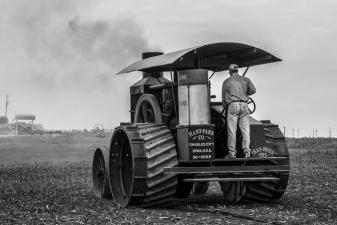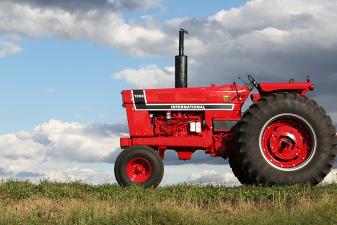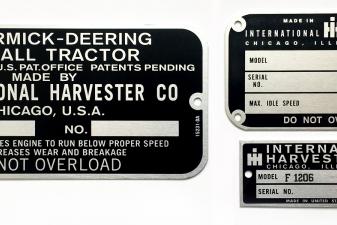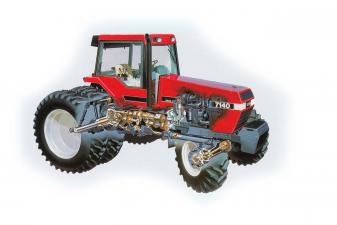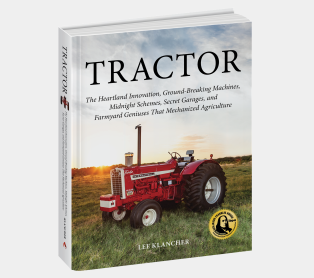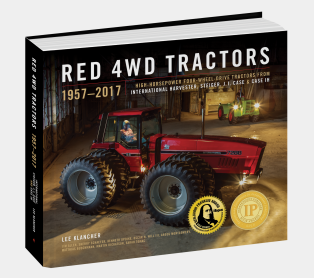Magnum: The Tractor That Saved the Brand
An Excerpt from TRACTOR

With incompatible engineering and diverging company ethos, the International Harvester and J. I. Case merger was inharmonious at best. With a deeply instilled “Us versus Them” mentality splitting the camps, an olive branch was needed. That olive branch would be delivered in the form of the Magnum. Read more in this excerpt from our upcoming book, TRACTOR, available for purchase now with FREE SHIPPING until August 10th.
The Case IH merger was one of the most difficult transitions for any agricultural company of the 1980s. J. I. Case and International Harvester were not terribly complementary lines of machinery, and the two groups had different ethics and opinions about their position in the market.
“There was always, for several years, what we called ‘Us’ and ‘Them,’” IH engineer Ben McCash said. “For some people it never went away.”
The dealership network also had lots of overlap, and many dealerships would be forced to close their doors. The fallout for the way this merger was handled, and the inevitable conflict that occurred, lasted for decades.
The way to heal that wound and move forward was with a new tractor. Thankfully for all involved, the money former IH CEO Archie McCardell lavished on research and development in the last days of IH paid dividends.
Shortly after the merger, Tenneco leader Jim Ketelsen met with his new chief engineer, Dr. Glenn Kahle, to discuss what he could do going forward. Kahle told him they had a new 100-plus-horsepower tractor on the drawing board. They had a new synchronized transmission and some other bits good to go, not to mention lots of ideas—including a brand-new cab design—that Harvester hadn’t been able to fund.
“How soon can we get it out?” Ketelsen asked. Kahle said two years, and as best he could determine, about $40 million was required to finish the work on the new model. Ketelsen quickly agreed, giving Kahle a fistful of dollars and a mandate: transform the final Harvester tractor into the first new tractor produced by Case IH.
Those funds were fuel for Kahle and his engineers to excel. One of the key things that made the Magnum was this group’s level of dedication to making sure the tractor was done right. In December 1986, the Japanese gear supplier, Okubo Gear Co., Ltd., was having issues interpreting the drawings and manufacturing questions.
Wanting to ensure the company knew the expectations for delivering the finished parts, Kahle sent over one of his lead engineers, George Vater, to fix the issue. The complication? This was right before Christmas.
“I think we were going on a Christmas holiday and they told me, ‘They want you over in Japan tomorrow.’ So I had to go down to the Japanese consulate, get my visa and go to Japan the next day,” Vater said. “I was there from the 21st of December to I think about the very last day in December.”
This was just one example of the dedication it took to compete—and survive—in that era.
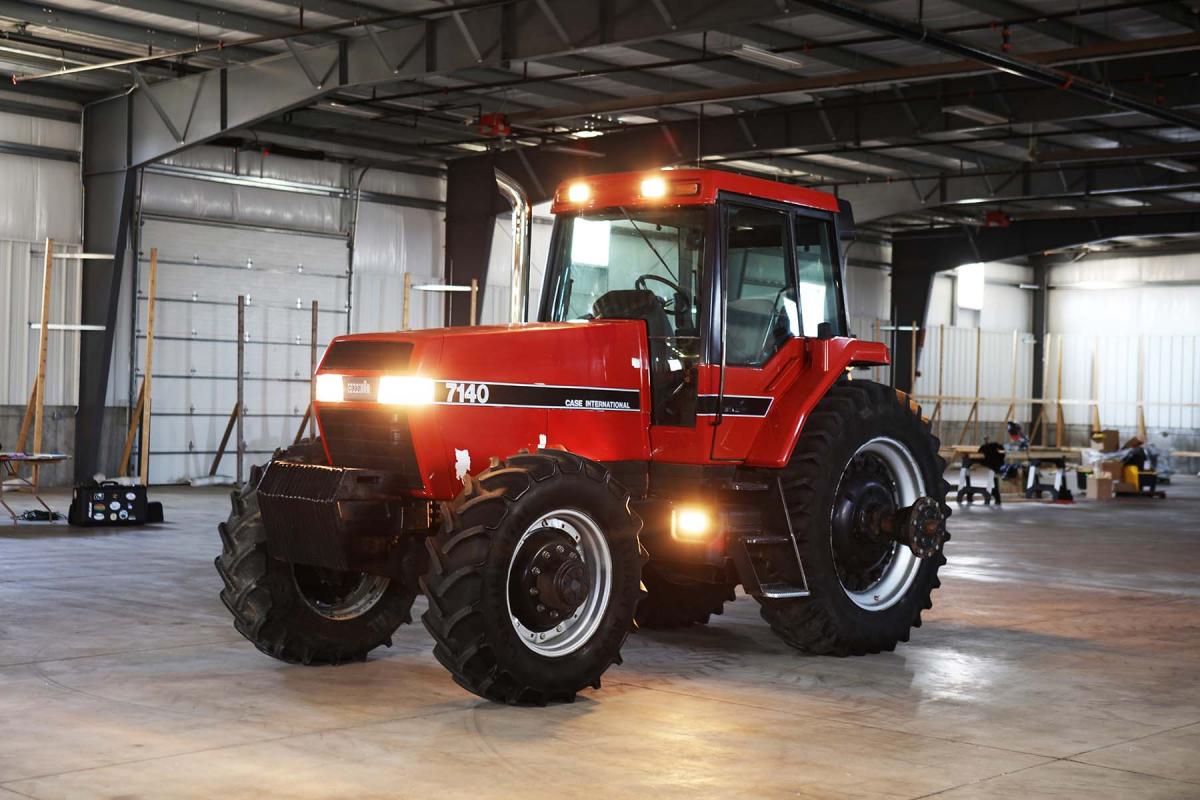 The original Magnum appeared in 1987. This example was sold at auction in Spring 2018, billed as the first retailed Magnum 7140, with a letter of authenticity from Case IH. Mecum Auctions / Lee Klancher
The original Magnum appeared in 1987. This example was sold at auction in Spring 2018, billed as the first retailed Magnum 7140, with a letter of authenticity from Case IH. Mecum Auctions / Lee Klancher
For the employees who made a living wage making the machines, the dealers who survived by selling and servicing them, and the farmers who fed their families using the machines, times remained very hard. Fresh new blood in the form of a class-leading machine was necessary for any of these groups to maintain their way of life.
The Magnum would prove to be exactly what was required. With a great new look, innovative internals, and well-tested components, the Magnum was a resounding success. The tractor’s CDC engine produced outstanding fuel economy and horsepower. The look was strong and bold, and the tractor raised the bar for high-horsepower two-wheel-drive machines. The cab also set new standards—and that was an area red tractors had been behind on from the 1960s.
Despite its success, the times were rough enough that the Magnum alone couldn’t save Case IH. The new model was introduced in August 1987—near the very bottom of the second-worst time in recorded history for the farmer. Throughout 1988, pundits and industry experts forecast resurgence and growth for the farm economy. Droughts and other forces kept that from happening.
The company’s survival would be dependent on a farm resurgence. But Case IH had loaded its larders with an agricultural weapon that was good enough to overcome the doubts of those who saw the world through paint colors.
“The success of that tractor saved the company, and it not only saved it but it solidified us as a true company, it brought the two sides together,” Warner said. “Both the Case dealer and the IH dealer, or the Case employee and the IH employee, could feel just as proud about that product as the other. And it really solidified our company.”
 The Magnum's sleek look takes center stage in this concept drawing created after the production of the original MAGNUM. Case IH
The Magnum's sleek look takes center stage in this concept drawing created after the production of the original MAGNUM. Case IH
Find all the stories behind your most beloved models in our upcoming book, TRACTOR, available for purchase now with FREE SHIPPING until August 10th.
The Case IH merger was one of the most difficult transitions for any agricultural company of the 1980s. J. I. Case and International Harvester were not terribly complementary lines of machinery, and the two groups had different ethics and opinions about their position in the market.
“There was always, for several years, what we called ‘Us’ and ‘Them,’” IH engineer Ben McCash said. “For some people it never went away.”
The dealership network also had lots of overlap, and many dealerships would be forced to close their doors. The fallout for the way this merger was handled, and the inevitable conflict that occurred, lasted for decades.
The way to heal that wound and move forward was with a new tractor. Thankfully for all involved, the money former IH CEO Archie McCardell lavished on research and development in the last days of IH paid dividends.
Shortly after the merger, Tenneco leader Jim Ketelsen met with his new chief engineer, Dr. Glenn Kahle, to discuss what he could do going forward. Kahle told him they had a new 100-plus-horsepower tractor on the drawing board. They had a new synchronized transmission and some other bits good to go, not to mention lots of ideas—including a brand-new cab design—that Harvester hadn’t been able to fund.
“How soon can we get it out?” Ketelsen asked. Kahle said two years, and as best he could determine, about $40 million was required to finish the work on the new model. Ketelsen quickly agreed, giving Kahle a fistful of dollars and a mandate: transform the final Harvester tractor into the first new tractor produced by Case IH.
Those funds were fuel for Kahle and his engineers to excel. One of the key things that made the Magnum was this group’s level of dedication to making sure the tractor was done right. In December 1986, the Japanese gear supplier, Okubo Gear Co., Ltd., was having issues interpreting the drawings and manufacturing questions.
Wanting to ensure the company knew the expectations for delivering the finished parts, Kahle sent over one of his lead engineers, George Vater, to fix the issue. The complication? This was right before Christmas.
“I think we were going on a Christmas holiday and they told me, ‘They want you over in Japan tomorrow.’ So I had to go down to the Japanese consulate, get my visa and go to Japan the next day,” Vater said. “I was there from the 21st of December to I think about the very last day in December.”
This was just one example of the dedication it took to compete—and survive—in that era.
 The original Magnum appeared in 1987. This example was sold at auction in Spring 2018, billed as the first retailed Magnum 7140, with a letter of authenticity from Case IH. Mecum Auctions / Lee Klancher
The original Magnum appeared in 1987. This example was sold at auction in Spring 2018, billed as the first retailed Magnum 7140, with a letter of authenticity from Case IH. Mecum Auctions / Lee KlancherFor the employees who made a living wage making the machines, the dealers who survived by selling and servicing them, and the farmers who fed their families using the machines, times remained very hard. Fresh new blood in the form of a class-leading machine was necessary for any of these groups to maintain their way of life.
The Magnum would prove to be exactly what was required. With a great new look, innovative internals, and well-tested components, the Magnum was a resounding success. The tractor’s CDC engine produced outstanding fuel economy and horsepower. The look was strong and bold, and the tractor raised the bar for high-horsepower two-wheel-drive machines. The cab also set new standards—and that was an area red tractors had been behind on from the 1960s.
Despite its success, the times were rough enough that the Magnum alone couldn’t save Case IH. The new model was introduced in August 1987—near the very bottom of the second-worst time in recorded history for the farmer. Throughout 1988, pundits and industry experts forecast resurgence and growth for the farm economy. Droughts and other forces kept that from happening.
The company’s survival would be dependent on a farm resurgence. But Case IH had loaded its larders with an agricultural weapon that was good enough to overcome the doubts of those who saw the world through paint colors.
“The success of that tractor saved the company, and it not only saved it but it solidified us as a true company, it brought the two sides together,” Warner said. “Both the Case dealer and the IH dealer, or the Case employee and the IH employee, could feel just as proud about that product as the other. And it really solidified our company.”
 The Magnum's sleek look takes center stage in this concept drawing created after the production of the original MAGNUM. Case IH
The Magnum's sleek look takes center stage in this concept drawing created after the production of the original MAGNUM. Case IHFind all the stories behind your most beloved models in our upcoming book, TRACTOR, available for purchase now with FREE SHIPPING until August 10th.


